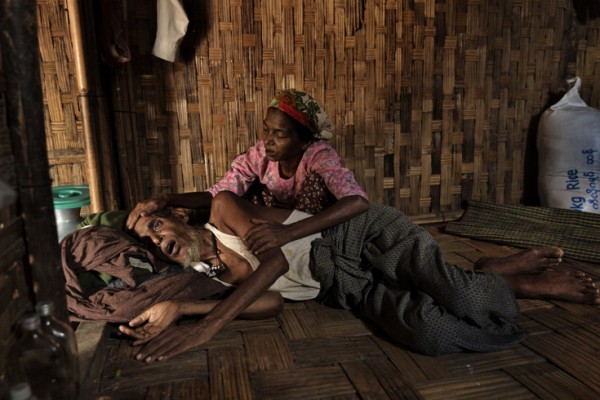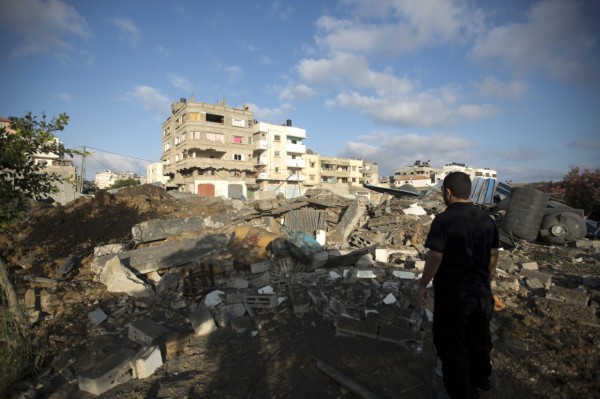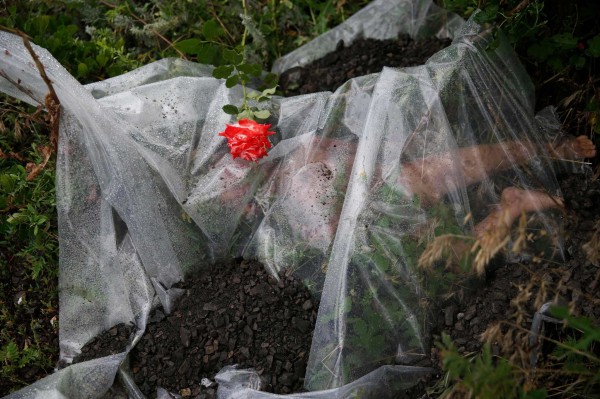Notes
And Then, There's Burma
This photo is a beautiful affirmation of human dignity, commitment, and compassion, in a place that is the work of tyranny, betrayal, and brutality. The two individuals are in a concentration camp in Burma/Myanmar, one of several camps holding over 100,000 Rohingya and other Buddhist ethnic minorities. Now that aid workers, including those who could provide medical care, have been removed from the camps by the government, the condition of the internees is deteriorating badly. Time Lightbox reports that “In June a top U.N. aid official who traveled to Rakhine said she had never before ‘witnessed [such] a level of human suffering.’”
The caption said that “Abdul Kadir, 65, who has a severe stomach ailment and malnutrition, is cared for by his wife in one of the camps.” But she isn’t caring for him, she is comforting him. That’s all she–or you–could do without access to the right food and medicine. The photograph reveals just how limited our individual capacity for action usually is, and how forced deprivation makes it more meager still. Love and a lifetime together count for a lot, but stripped of the support networks that define a normal society, all humane values can be made to look helpless.
As an aside, it’s moments like this that make me really irritated with those on both the right and the left who say that the problem then lies with those values (often empathy or compassion is the target), rather than with the forces that overpower them. And for the same reason I now am even more disgusted with the extent to which popular entertainment peddles magical capacities for action, whether seen in steroidal superheroes or prissy British kids with magic wands. There are no magic wands in the camps, and heroes get sick and die.
These digressions may hint at an important dimension of the photograph, placed as it is within Time’s photo essay on the persecution of the Rohingya. This larger implication begins with how the photo captures both the nobility of and limits on caring for another human being. That double observation alone could be used against the idea of compassion, not least as the woman’s behavior elicits a similar impulse from the very distant spectator, but that would be mistaken. Instead, the photograph underscores how neither the cause nor the remedy of the man’s distress is a matter of individual action. We each act individually as we are given the resources to do so; when crucial resources have been intentionally, systematically taken away by those in power, there often is little one can do to help another beyond the simplest gestures.
Let’s say it: concentration camps are a form of collective torture. It is torture, because the withholding or food, water, and medicine while forcing people to live in squalor and do hard labor while malnourished causes constant suffering that is intended to destroy them psychologically and then in every other way as well. The process is collective in two senses: a large group of people are being tortured at once, and they are being tortured by another group of people. Whatever may be said about it, one cannot claim that this is the work of only “a few bad apples.” The deprivation is the work of a government, and of a government that is having no trouble enlisting large numbers of its citizens and their religious leaders as accomplices.
While the world is fixated on Gaza, the Muslims in Burma/Myanmar bear the added trauma of being ignored or otherwise considered not worth saving. I don’t see the Saudis or Qatar pouring money into the camps, and I don’t expect to see the American Secretary of State making a visit any time soon. Such actions at some point would involve individual decision-makers, but they would remain powerfully collective responses. What the photograph above shows is not only the limited scope of personal action by ordinary people, but also the moral and political scandal of their abandonment.
— Robert Hariman
(cross-posted from No Caption Needed.)
(photo: James Nachtwey/Time Lightbox. caption: Rohingye people, a Muslim population, living in Rakhine State on the northwest coast of Burma have been restricted to their villages and placed in Internally Displaced Peoples (IDP) camps by the Burmese government. They have been the victims of persecution and communal violence by numbers of the Buddhist majority in Rakhine. International NGO’s such as MSF have been expelled by the government, leading to a soaring crisis in health care.)



Reactions
Comments Powered by Disqus